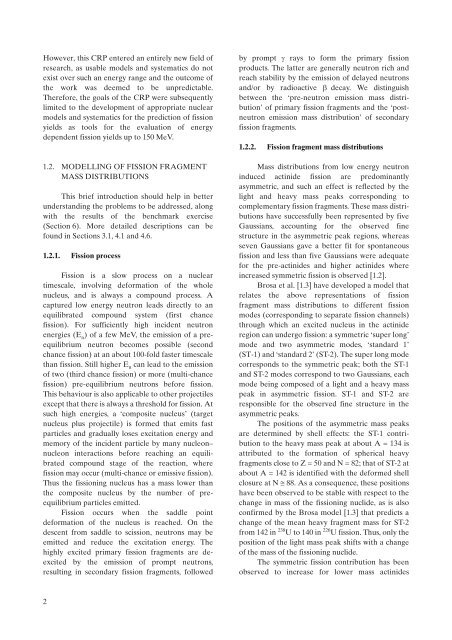Fission Product Yield Data for the Transmutation of Minor Actinide ...
Fission Product Yield Data for the Transmutation of Minor Actinide ...
Fission Product Yield Data for the Transmutation of Minor Actinide ...
Create successful ePaper yourself
Turn your PDF publications into a flip-book with our unique Google optimized e-Paper software.
However, this CRP entered an entirely new field <strong>of</strong><br />
research, as usable models and systematics do not<br />
exist over such an energy range and <strong>the</strong> outcome <strong>of</strong><br />
<strong>the</strong> work was deemed to be unpredictable.<br />
There<strong>for</strong>e, <strong>the</strong> goals <strong>of</strong> <strong>the</strong> CRP were subsequently<br />
limited to <strong>the</strong> development <strong>of</strong> appropriate nuclear<br />
models and systematics <strong>for</strong> <strong>the</strong> prediction <strong>of</strong> fission<br />
yields as tools <strong>for</strong> <strong>the</strong> evaluation <strong>of</strong> energy<br />
dependent fission yields up to 150 MeV.<br />
1.2. MODELLING OF FISSION FRAGMENT<br />
MASS DISTRIBUTIONS<br />
This brief introduction should help in better<br />
understanding <strong>the</strong> problems to be addressed, along<br />
with <strong>the</strong> results <strong>of</strong> <strong>the</strong> benchmark exercise<br />
(Section 6). More detailed descriptions can be<br />
found in Sections 3.1, 4.1 and 4.6.<br />
1.2.1. <strong>Fission</strong> process<br />
<strong>Fission</strong> is a slow process on a nuclear<br />
timescale, involving de<strong>for</strong>mation <strong>of</strong> <strong>the</strong> whole<br />
nucleus, and is always a compound process. A<br />
captured low energy neutron leads directly to an<br />
equilibrated compound system (first chance<br />
fission). For sufficiently high incident neutron<br />
energies (E n ) <strong>of</strong> a few MeV, <strong>the</strong> emission <strong>of</strong> a preequilibrium<br />
neutron becomes possible (second<br />
chance fission) at an about 100-fold faster timescale<br />
than fission. Still higher E n can lead to <strong>the</strong> emission<br />
<strong>of</strong> two (third chance fission) or more (multi-chance<br />
fission) pre-equilibrium neutrons be<strong>for</strong>e fission.<br />
This behaviour is also applicable to o<strong>the</strong>r projectiles<br />
except that <strong>the</strong>re is always a threshold <strong>for</strong> fission. At<br />
such high energies, a ‘composite nucleus’ (target<br />
nucleus plus projectile) is <strong>for</strong>med that emits fast<br />
particles and gradually loses excitation energy and<br />
memory <strong>of</strong> <strong>the</strong> incident particle by many nucleon–<br />
nucleon interactions be<strong>for</strong>e reaching an equilibrated<br />
compound stage <strong>of</strong> <strong>the</strong> reaction, where<br />
fission may occur (multi-chance or emissive fission).<br />
Thus <strong>the</strong> fissioning nucleus has a mass lower than<br />
<strong>the</strong> composite nucleus by <strong>the</strong> number <strong>of</strong> preequilibrium<br />
particles emitted.<br />
<strong>Fission</strong> occurs when <strong>the</strong> saddle point<br />
de<strong>for</strong>mation <strong>of</strong> <strong>the</strong> nucleus is reached. On <strong>the</strong><br />
descent from saddle to scission, neutrons may be<br />
emitted and reduce <strong>the</strong> excitation energy. The<br />
highly excited primary fission fragments are deexcited<br />
by <strong>the</strong> emission <strong>of</strong> prompt neutrons,<br />
resulting in secondary fission fragments, followed<br />
2<br />
by prompt γ rays to <strong>for</strong>m <strong>the</strong> primary fission<br />
products. The latter are generally neutron rich and<br />
reach stability by <strong>the</strong> emission <strong>of</strong> delayed neutrons<br />
and/or by radioactive β decay. We distinguish<br />
between <strong>the</strong> ‘pre-neutron emission mass distribution’<br />
<strong>of</strong> primary fission fragments and <strong>the</strong> ‘postneutron<br />
emission mass distribution’ <strong>of</strong> secondary<br />
fission fragments.<br />
1.2.2. <strong>Fission</strong> fragment mass distributions<br />
Mass distributions from low energy neutron<br />
induced actinide fission are predominantly<br />
asymmetric, and such an effect is reflected by <strong>the</strong><br />
light and heavy mass peaks corresponding to<br />
complementary fission fragments. These mass distributions<br />
have successfully been represented by five<br />
Gaussians, accounting <strong>for</strong> <strong>the</strong> observed fine<br />
structure in <strong>the</strong> asymmetric peak regions, whereas<br />
seven Gaussians gave a better fit <strong>for</strong> spontaneous<br />
fission and less than five Gaussians were adequate<br />
<strong>for</strong> <strong>the</strong> pre-actinides and higher actinides where<br />
increased symmetric fission is observed [1.2].<br />
Brosa et al. [1.3] have developed a model that<br />
relates <strong>the</strong> above representations <strong>of</strong> fission<br />
fragment mass distributions to different fission<br />
modes (corresponding to separate fission channels)<br />
through which an excited nucleus in <strong>the</strong> actinide<br />
region can undergo fission: a symmetric ‘super long’<br />
mode and two asymmetric modes, ‘standard 1’<br />
(ST-1) and ‘standard 2’ (ST-2). The super long mode<br />
corresponds to <strong>the</strong> symmetric peak; both <strong>the</strong> ST-1<br />
and ST-2 modes correspond to two Gaussians, each<br />
mode being composed <strong>of</strong> a light and a heavy mass<br />
peak in asymmetric fission. ST-1 and ST-2 are<br />
responsible <strong>for</strong> <strong>the</strong> observed fine structure in <strong>the</strong><br />
asymmetric peaks.<br />
The positions <strong>of</strong> <strong>the</strong> asymmetric mass peaks<br />
are determined by shell effects: <strong>the</strong> ST-1 contribution<br />
to <strong>the</strong> heavy mass peak at about A = 134 is<br />
attributed to <strong>the</strong> <strong>for</strong>mation <strong>of</strong> spherical heavy<br />
fragments close to Z = 50 and N = 82; that <strong>of</strong> ST-2 at<br />
about A = 142 is identified with <strong>the</strong> de<strong>for</strong>med shell<br />
closure at N ≅ 88. As a consequence, <strong>the</strong>se positions<br />
have been observed to be stable with respect to <strong>the</strong><br />
change in mass <strong>of</strong> <strong>the</strong> fissioning nuclide, as is also<br />
confirmed by <strong>the</strong> Brosa model [1.3] that predicts a<br />
change <strong>of</strong> <strong>the</strong> mean heavy fragment mass <strong>for</strong> ST-2<br />
from 142 in 238 U to 140 in 226 U fission. Thus, only <strong>the</strong><br />
position <strong>of</strong> <strong>the</strong> light mass peak shifts with a change<br />
<strong>of</strong> <strong>the</strong> mass <strong>of</strong> <strong>the</strong> fissioning nuclide.<br />
The symmetric fission contribution has been<br />
observed to increase <strong>for</strong> lower mass actinides

















